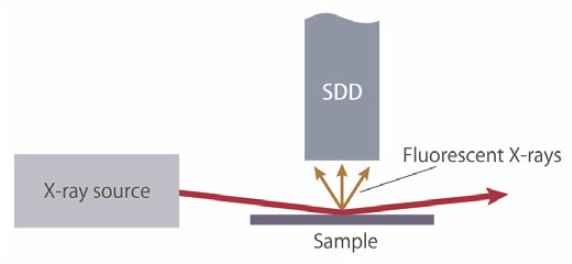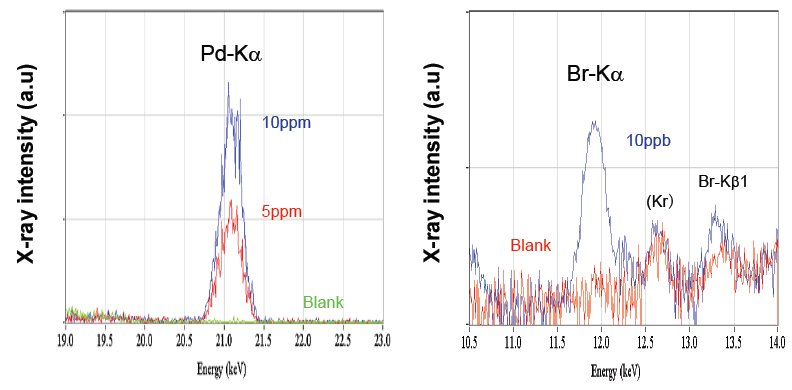Pharmaceutical Intermediates by TXRF
Introduction
In TXRF, an incident X-ray beam irradiated the sample at an extremely shallow angle and efficiently excites elements on the surface with little scattering of X-rays (Figure 1). It provides dramatically reduced background levels in the measured energy dispersive X-ray fluorescence spectra. Ultratrace elemental analysis in liquid samples becomes possible using the NANOHUNTER II in combination with the “Drop and Dry” sample preparation technique.

Figure 1: TXRF principle
Measurement and results
XRF has been considered as a useful method for impurity analysis for its short measurement time and few spectral overlaps even for multi-element matrices. In addition, analysis by TXRF has the advantage that only a small amount of sample is required compared to other methods. The analysis of pharmaceutical products is carried out in both the development phase and quality control of the final products. In particular, in the development stage, rapid and simple analytical method such as the confirmation of active compound tags and residual catalysts has been required. TXRF can meet these requirements.
In TXRF, the glass substrate on which 10 µL of the liquid sample is dropped and dried is measured. It is possible to perform qualitative analysis with simple sample preparation. For example, screening elemental analysis of intermediates can be performed in a short time. Furthermore, by using the internal standard addition method, it is possible to easily perform quantitative analysis of trace elements in aqueous solutions.
Congeners that are chemically similar in nature, such as Ni-Pd-Pt or Cl-Br, can also be measured separately. The qualitative spectra of ppm level Pd and 10 ppb of Br in aqueous solution are shown in Figure 2. Low background and good SN ratio spectra were obtained.
ICP-MS has issues such as waste water treatment, and therefore another simple analytical technique has been desired for the analysis of intermediate. Since TXRF can perform highly sensitive measurement with simple pretreatment, it is an applicable technique for screening analysis.

Figure 2: Spectra of Pd 10, 5 ppm, blank (left) and Br 10 ppb, blank (right)
Table 1: LLD (ppb)
| Hazardous metals | LLD |
| Cr | 3.8 |
| As | 0.88 |
| Se | 0.85 |
| Cd | 8.0 |
| Hg | 2.1 |
| Pb | 1.8 |
| Catalytic elements | LLD |
| Fe | 2.5 |
| Ni | 1.6 |
| Pd | 10 |
| Pt | 2.3 |

Contact Us
Whether you're interested in getting a quote, want a demo, need technical support, or simply have a question, we're here to help.
